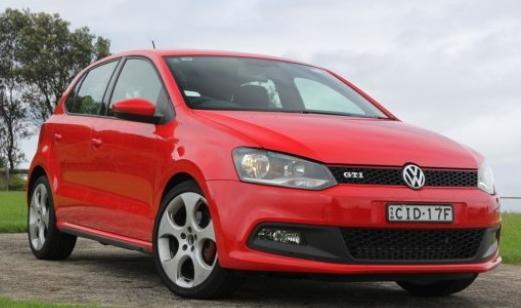You could blame the 2010 launch of the Volkswagen Polo GTI for the ongoing shift away from manual-transmission-equipped hot hatches to dual-clutch automatics.

There’s a case to argue that it’s all going the wrong way – that properly cooked hot hatches such as the Polo GTI should be sold with a manual and a third pedal, to increase the interaction between car and driver.
But Volkswagen is in the volume-selling game, and simply put, it can a sell more Polo GTIs (and Golfs) with dual clutch automatics (dubbed Direct Shift Gearbox, or DSG, by the maker) than manual-only versions. Renault has followed suit with its new-generation Clio RS for the same reason.
But the move away from the traditional manual gearbox to a quick-shifting dual-clutch actually helps the Polo GTI’s performance. It’s the quickest car in its class, able to sprint from 0-100km/h in just 6.9 seconds. For $27,790 for the three door, and $28,990 for the five door, it remains the cheapest way to go that fast for less than $30K.
Rival hatches such as Mini Cooper S, Opel OPC Corsa and the all-new Clio RS all need 7.2 seconds to hit the 100km/h mark.
The Polo GTI’s relatively meagre 1.4-litre displacement makes it the smallest engine in the class, with the above-mentioned competitors utilising 1.6-litre engines. This seeming discrepancy is allayed by the Polo GTI’s use of forced induction – multiplied by two.
With the help of both a supercharger (which boosts the engine up to 3000rpm) and a turbocharger (that takes the reigns from thereafter), along with direct injection, the Polo GTI sends an impressive 132kW of power and 250Nm of torque (the latter delivered from 2000 to 4500rpm) to the front wheels.
It’s frugal too, with a fuel consumption reading of just 6.1-litres/100km over a several hundred-kilometre stint behind the wheel – courtesy of its seven-speed DSG.
However, it’s worth mentioning that careful use of the throttle is required when pulling out of busy intersections to avoid front wheel-spin and mild torque steer, even in the dry.
The Polo GTI also sounds pretty good, with its gruff, rorty induction note from low-down in the rev range providing a modest dose of aural delight from the get-go.
Upshifts are lightning-fast when blasting along at a reasonable lick – seamless, too. Conversely, the DSG can feel lazy when just ambling around the city.
There’s a ‘Sport’ auto mode that will hold shift points to higher up in the rev range, but it isn’t aggressive enough when auto-downchanging under brakes during hard driving.
Nor is the manual tipshift facility, with accompanying steering-wheel-mounted paddles, particularly intuitive, often denying a downshift when hard on the brakes coming into a corner – in a manual, you’d simply buck the throttle with your right foot to bring revs up, then change back a gear or two.
The Polo is still a genuinely fun drive, however, with accurate steering (even if it lacks feedback), strong brakes and a solid bite from the Dunlop SP’s on turn-in.
Too much throttle out of corners though will cause the ESP warning light to flash like a strobe – all too often – and that’s with the system well and truly deactivated (as tested on a closed track).
It’s certainly solid through the bends, with minimal body roll and a confident composure that urges you to push on.
But as good as the Polo GTI is, it can’t quite match more focused rivals such as the Opel OPC Corsa or Renault Clio RS in the chassis-tuning department.
It also can’t match either a lesser-grade Polo 77TSI or Golf GTI for ride comfort, feeling lumpy and brittle at low speeds. But it does offer exceptional control at speed on rough roads.
It’s also well insulated – modern Volkswagens are like that – with engine noise (except for the good stuff) kept well away from the confines of the GTI’s cabin.
And what a cabin it is – this is where the Polo GTI really shines. From the body-hugging, yet superbly supportive tartan seats, to the Golf GTI-style, flat-bottomed steering wheel and an assortment of top-shelf plastics, the Polo actually feels much like the larger Golf inside.
Standard features include automatic climate control, daytime driving lights, 6.5-inch touchscreen controlling media, phone and music (no standard Sat-Nav), Bluetooth phone and music streaming, auto dimming rear-view mirror, auto-sensing headlamps and wipers and 17-inch alloy wheels round out the highlights.
Comfort levels are high in the five-door variant (tested), with sufficient rear legroom for comfortable long distance travel for four adults.
Sadly, luggage space is restricted to 204-litres (with the rear seatbacks up) due to a high floor that hides a space saver wheel. Folded flat – the Polo’s load space expands to 882 litres.
With less design flair than its aforementioned rivals, it’s not the most gregarious of shapes, but the Polo GTI still manages to maintain a special presence on the road.
There are the twin tailpipes, honeycomb grille with red stripes and that GTI interior that at least set it apart from its regular Polo siblings.
From certain angles you might even have trouble picking it from its big brother Golf GTI – such is the likeness from the front-on.
Die-hard enthusiasts probably won’t be tempted by its exceptional build quality or all-round practicality alone, but the Polo GTI does everything you ask of it and then some, albeit without the same level of feedback provided by rival hatches.





